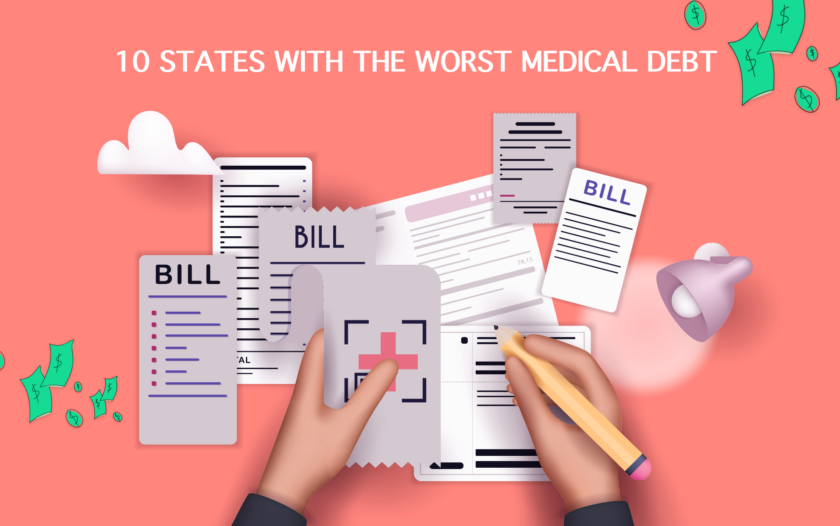If You Live in This State, You Have the Worst Medical Debt
About Meredith
Meredith Lepore is a content editor for Credello. Her work has appeared in Travel & Leisure, The Observer, InStyle, Marie Claire, Refinery29, Brides, Architectural Digest, Business Insider, and TIME. She earned a Master's in Journalism from the Newhouse School at Syracuse University.
Read full bio
At a Glance
Dealing with medical debt can be a harrowing experience for countless Americans (nearly 1 in every 10 adults in the U.S. have medical debt or 23 million people.) When illness or injury strikes, the financial burden can quickly become overwhelming. A recent study conducted by Florida Personal Injury Lawyers Anidjar Levine has shed light on the prevalence of medical debt in collections across the U.S., revealing that some states are grappling with this issue more than others.
This research analyzed data from the Urban Institute Data Catalog to discover the percentage of the population with medical debt in collections in each state, along with the median amount. The findings are a sobering reminder of the financial challenges many Americans face due to healthcare costs.
In this article, you’ll learn:
The Top 10 States with the Highest Percentage of People in Medical Debt Collections
1. West Virginia:
- Share with Medical Debt in Collections: 23.97%
- Median Medical Debt in Collections: $553
2. South Carolina:
- Share with Medical Debt in Collections: 22.26%
- Median Medical Debt in Collections: $860
3. Oklahoma:
- Share with Medical Debt in Collections: 21.46%
- Median Medical Debt in Collections: $893
4. North Carolina:
- Share with Medical Debt in Collections: 20.29%
- Median Medical Debt in Collections: $742
5. Texas:
- Share with Medical Debt in Collections: 18.82%
- Median Medical Debt in Collections: $835
6. Louisiana:
- Share with Medical Debt in Collections: 18.06%
- Median Medical Debt in Collections: $726
7. Arkansas:
- Share with Medical Debt in Collections: 17.78%
- Median Medical Debt in Collections: $561
8. Tennessee:
- Share with Medical Debt in Collections: 17.63%
- Median Medical Debt in Collections: $888
9. Georgia:
- Share with Medical Debt in Collections: 17.33%
- Median Medical Debt in Collections: $855
10. Kentucky:
- Share with Medical Debt in Collections: 17.11%
- Median Medical Debt in Collections: $491
But there are states that aren’t as in bad shape.
The Top 10 states with the least medical debt in collections are:
- Minnesota (2.42%)
- South Dakota (3.17%)
- Alaska (3.88%)
- Massachusetts (4.03%)
- Vermont (4.71%)
- Oregon (4.78%)
- Washington (4.97%)
- Hawaii (4.99%)
- Rhode Island (5.11%)
- New York (5.57%)
The study found that the median medical debt in collections for all states was $418. However, the median medical debt in collections varied widely from state to state, with the highest median debt of $683 in South Dakota and the lowest median debt of $339 in Hawaii.
Contributing factors to medical debt
There are a number of factors that may contribute to a state’s medical debt rate. One factor is the state’s Medicaid expansion status. States that have expanded Medicaid have lower rates of medical debt than states that have not expanded Medicaid. This is because Medicaid provides health insurance to low-income individuals and families, which helps them to afford necessary medical care.
Another factor that may contribute to a state’s medical debt rate is the state’s healthcare costs. States with higher healthcare costs tend to have higher rates of medical debt. This is because higher healthcare costs can make it more difficult for people to afford necessary medical care.
Bottom Line
The high rates of medical debt in the U.S. are a serious problem. Medical debt can have a number of negative consequences for individuals, including financial hardship, bankruptcy, and difficulty accessing necessary medical care.
The high percentages of individuals with medical debt in these states may be attributed to various factors, including the cost of healthcare, access to insurance, and economic conditions. It’s a clear indication that many Americans are struggling to keep up with medical expenses, which can have far-reaching consequences for their financial well-being.









